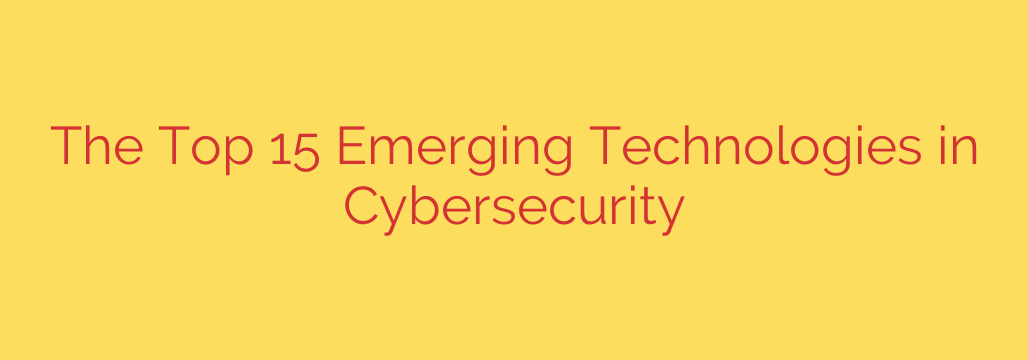
Staying Ahead: Key Emerging Technologies Shaping Cybersecurity
The digital landscape evolves at lightning speed, and unfortunately, so do the tactics of malicious actors. As threats become more sophisticated and pervasive, the cybersecurity field must constantly innovate. Staying informed about emerging technologies isn’t just beneficial; it’s absolutely critical for protecting data, systems, and reputations.
Here’s a look at some of the most impactful advancements shaping the future of cybersecurity:
AI and Machine Learning for Enhanced Defense
Perhaps the most transformative force is the application of Artificial Intelligence (AI) and Machine Learning (ML) in security. These technologies are revolutionizing threat detection and response.
- Faster Threat Detection: AI/ML can analyze vast amounts of data in real-time – far exceeding human capability – to identify subtle anomalies and patterns indicative of an attack. This allows for much quicker identification of threats like malware, phishing attempts, and insider threats.
- Predictive Security: Beyond detection, AI algorithms can learn from past incidents and current network behavior to predict potential future attacks or vulnerabilities.
- Automated Response: AI-powered systems can trigger automated responses to contain threats immediately, reducing the window of opportunity for attackers.
While powerful, it’s important to remember that AI in security requires careful implementation and continuous monitoring to avoid biases or the potential for adversaries to use AI against defenses.
Embracing the Zero Trust Model
The traditional security perimeter is dissolving with the rise of cloud computing, remote work, and mobile devices. This shift necessitates a new paradigm: Zero Trust Architecture (ZTA).
- Verify Explicitly: The core principle of Zero Trust is “never trust, always verify.” No user, device, or application is trusted by default, regardless of its location within or outside the traditional network boundary.
- Least Privilege Access: Users and devices are granted only the minimal access required to perform their specific tasks.
- Continuous Authentication and Authorization: Verification is not a one-time event but is performed continuously based on context like user behavior, device posture, and data sensitivity.
Implementing Zero Trust is a journey, not a destination, requiring significant changes in infrastructure, policy, and culture. However, it provides a far more resilient defense against modern threats, especially sophisticated breaches that exploit trust assumptions.
Fortifying the Cloud and Distributed Environments
As organizations migrate critical operations to the cloud and adopt distributed architectures like containers and serverless functions, securing these environments becomes paramount.
- Cloud-Native Security Tools: Leveraging security tools and features built specifically for cloud platforms (AWS, Azure, GCP) is essential. These often integrate deeply with the cloud infrastructure.
- Container Security: Technologies for scanning, securing, and monitoring containerized applications (like Docker and Kubernetes) throughout their lifecycle are critical to prevent vulnerabilities from being deployed.
- Security Service Edge (SSE) & SASE: The convergence of network and security functions into cloud-delivered services (SSE), often part of the broader Secure Access Service Edge (SASE) framework, simplifies security management and provides consistent policy enforcement for distributed workforces.
Effective cloud security requires understanding the shared responsibility model – clearly defining what the cloud provider secures versus what the customer is responsible for.
The Horizon: Quantum Security and Confidential Computing
Looking further ahead, two technologies address future and current data protection challenges in novel ways:
- Post-Quantum Cryptography (PQC): As quantum computing advances, it poses a potential threat to current encryption standards. PQC involves developing new cryptographic algorithms designed to withstand attacks from future quantum computers. Research and standardization in this area are accelerating.
- Confidential Computing: This emerging field focuses on protecting data while it is being processed. Using trusted execution environments (TEEs), Confidential Computing encrypts data in memory, preventing unauthorized access even from the underlying infrastructure provider.
These technologies, while still maturing, highlight the ongoing need to anticipate future threats and explore innovative methods for ensuring data privacy and integrity.
Staying Ahead of the Curve
The pace of change in cybersecurity means organizations must be proactive. Regularly assessing your security posture, investing in employee training, and adopting a layered security approach that incorporates these emerging technologies are vital steps. The goal isn’t just to react to threats but to build resilient systems capable of adapting to the challenges of tomorrow.
Source: https://kifarunix.com/top-15-emerging-technology-in-cybersecurity/








